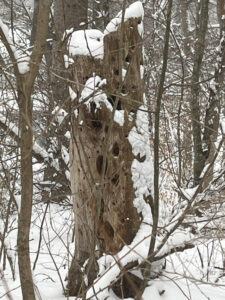 Even though I don’t have kids in school or a job that typically requires me to change out of my pajamas and go somewhere, snow days are still a wonderful gift. The calendar is suddenly cleared and the day gloriously at my disposal. I sleep late and read and write all morning and take a nap in the afternoon. I eat whatever’s in the refrigerator and pantry, whether I’m in the mood for it or not. Nobody calls asking me to do something, fun or otherwise.
Even though I don’t have kids in school or a job that typically requires me to change out of my pajamas and go somewhere, snow days are still a wonderful gift. The calendar is suddenly cleared and the day gloriously at my disposal. I sleep late and read and write all morning and take a nap in the afternoon. I eat whatever’s in the refrigerator and pantry, whether I’m in the mood for it or not. Nobody calls asking me to do something, fun or otherwise.
And snow days give me the perfect opportunity to watch the birds. They’re at my feeders year-round, but when snow blankets the ground they come in great waves to feast on sunflower seed and suet. Blue jays and mockingbirds. Tufted titmice (or is it mouses?) and chickadees. Finches and sparrows. And cardinals, the males shockingly scarlet against the white snow.
The birds I love best are woodpeckers. Though considered nuisances by their detractors, woodpeckers have always been my favorite. I’m crazy about the diminutive downy, at just six inches long the smallest woodpecker in North America. Next in line is the red-bellied woodpecker, about the size of a blue jay. It has no crest but does have a wide strip of red running from the base of the beak over the head. Its face and belly are white with tinges of red (thus the name) and its wings are black-and-white striped. This bird is often called a red-headed woodpecker, but that’s wrong. More about this in a minute.
Then there’s the pileated woodpecker, sometimes known as the “Good Lord Bird” because, upon spotting it, observers often exclaim, “Good Lord, did you see that bird?” Big as a crow and just as noisy, this long-necked woodpecker has a bright red crest and a powerful chisel-like beak. I hang a special suet feeder equipped with a tail rest especially to attract pileated woodpeckers.
For me, the red-headed woodpecker is most special because it’s one I seldom see. About the size of a robin, this bird has an un-crested head that’s bright red. Its belly is snow-white and its wings are half-white and half-inky black. Classified as near-threatened, red-headed woodpeckers have declined in number because of habitat loss and disruption of food sources. That’s why I’m always so delighted to spot them at my feeder.
Woodpeckers are one reason I love the woods in winter. I’m lucky enough to live just outside the city limits in a neighborhood filled with forested acreage. Jungle-like in spring and summer and bursting with color in the fall, these woods become extra-special during the winter months. It’s easier to tromp through them when the undergrowth has shrunk back. It’s also a relief not to worry about ticks and poison ivy and copperheads.
In the winter woods, you notice things that aren’t so obvious in the warm months. Not just wildlife, though deer and raccoons and possums and rabbits and squirrels are definitely easier to spot. But so are trees stripped of their leaves. Bark and mushrooms and moss stand out. Especially interesting are the trees that have fallen, uprooted by age and soggy ground or blown over by the wind.
A jagged tree stump, six feet tall and with its bark rotted away, pokes out of the ground in the woods at the edge of my yard. It’s full of holes—27 of them and, yes, I counted–of various shapes and sizes. I like to believe it’s a woodpecker apartment complex that in spring will be filled with woodpecker babies of many varieties. Babies who’ll grow up and enjoy the feeders in my yard.
The stump is clearly visible from my bathroom window. It won’t be too many weeks before I’ll be hanging out near that window, binoculars at the ready and hoping against hope for yet another woodpecker column.
(January 20, 2023)